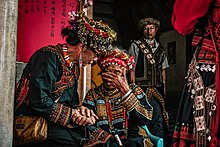Paiwan
The Paiwan (also Payuan , Chinese 排 灣 族 , Pinyin Páiwān zǔ ) are one of the indigenous peoples of Taiwan . With a population of 97,903 people (March 2016), the Paiwan are the third largest indigenous people in Taiwan after the Amis and the Atayal . Like all indigenous peoples of Taiwan, the Paiwan are also part of the Austronesian peoples and speak an Austronesian language .
Settlement area and history
According to a myth, "Paiwan" was originally the name of a paradisiacal place in the southern Taiwanese Dawu Mountains, where the ancestors of the Paiwan are said to have lived. After the settlement of the wider area by their descendants, the name was transferred to the tribe. When the west of the island of Taiwan was settled by Chinese immigrants, the Paiwan people living in the western plain were pushed back into the mountains or to the east coast.
The Paiwan split into two larger groups, the Raval and the Butsul, which in turn are made up of a number of individual village communities. Most of the Paiwan live in the mountains of southern Taiwan. Their settlement area extends from the Damumu Mountains in the Taiwanese Central Mountains in the north to the southern tip of the island, and east of the mountains to the coast of Taitung County .
language
The Paiwan belongs to the Formosa languages , a subgroup of the Austronesian languages . It is estimated that around two-thirds of the people still master the language, with very large differences in the level of mastery. As a result of the ongoing Sinization and the associated spread of Chinese , the number of younger speakers and native speakers is falling sharply. Attempts are now being made to counteract this development through support programs and language lessons.
society
Traditional Paiwan society was shaped by a caste system in which the chiefs and their families were at the head of the communities. This was followed by the caste of shamans, nobles and warriors, while the rest of the tribesmen belonged more or less to the lowest caste of the common people. Changing from one caste to another was partially possible through marriages. In some clans, however, it was forbidden to marry people outside of one's own clan.
The clothing of a person, the material and the decorations, were traditionally based on the caste to which they belong. The wearing of eagle feathers was reserved for chiefs only; the pattern of the snake Mura was only allowed to be worn by nobles. The lily as jewelry was only noblewomen allowed.
Religion and customs
The Paiwan were originally animists . The expression of the religion of the Paiwan are carved wooden totems , which usually had their place inside the dwellings and show animal bodies (often deer or snakes) with human heads and geometric patterns. In addition to a number of gods, the spirits of the ancestors were also worshiped. As a result of the activities of western missionaries, which began in the 17th century by the Dutch, most of the Paiwan profess Presbyterian Christianity today .
The most important traditional ceremonies are the Masaru and Maleveq ceremonies . The Masaru ceremony takes place on the occasion of the rice harvest; the Maleveq ceremony served to worship the Paiwan gods or the spirits of the ancestors.
Individual evidence
- ↑ Website of the Council for Indigenous Peoples of Taiwan (Chinese)
- ↑ Paiwan - A language of Taiwan on the Ethnologue website , accessed January 13, 2020.

